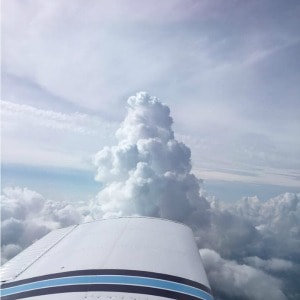
Adding an Instrument Rating to your certificate is not only very rewarding but also makes you a better pilot. All of our airplanes are IFR certified and the Redbird simulator is an excellent training tool for getting your rating. You can log up to 20 hours in the simulator for less than half the cost of renting an airplane!
Steps to getting an Instrument Rating:
1. Hold a Private Pilot certificate
Some people do their Private and Instrument training together, but you must either have your Private certificate already, or plan to take the Private and Instrument checkride on the same day.
2. Pass a written Knowledge Test at an approved testing center
This exam tests your knowledge about flight, the rules and regulations, and what you understand about the airplane. You can attend an Instrument ground school to prepare you for this exam, or do a home study course such as Sporty’s free test prep, Rod Machado’s Instrument Pilot course, or Gleim (these are just a few examples). Sheppard Air offers a money-back guarantee with their inexpensive test prep program.
Once you are ready to take the exam, you must go to an approved testing center, take a 60 question test on a computer, and pass with a score of at least 70%. You can find a list of testing centers in Indiana here.
The knowledge exam can be taken at any time during flight training. It only must be finished by the time you are ready to take your practical test. Some students like to take it before flight lessons so that it is done and they don’t have to worry about it. Other students prefer to take it later on in their flight training as some of the concepts make more sense once you’ve used them.
3. Fulfill the flight time requirements
The list below is a general overview. Click here for the complete requirements.
- 50 hours cross country time
- 40 hours of actual or simulated instrument time
- At least 15 hours of instrument flight training from an authorized instructor
- A cross-country flight of at least 250 nautical miles, using three different kinds of approaches at each airport
You can do up to 20 hours of the simulated instrument time in our Redbird simulator, which can reduce the cost of your instrument training! You can also log simulated time with another Private pilot in the right seat as a safety pilot while you practice “under the hood”. You and your friend can both log “PIC” time doing this.
If you are planning on getting your Commercial certificate, consider combining some of your required cross-country time while you do your instrument training with your instructor.
4. Pass a practical test (also known as a checkride) with an examiner
Once you’ve met all of the requirements for getting your Instrument Rating, and your instructor knows that you’re ready, he or she will sign you off to go take the “practical test”, also known as the checkride. You will meet with an examiner much like you did for your Private Pilot exam. Once you have passed this test, you are an instrument rated pilot!!! Go fly through some clouds!


